Mineralogical and Environmental Geochemistry of Coal Combustion Products from Shenhuo and Yihua Power Plants in Xinjiang Autonomous Region, Northwest China
Abstract
1. Introduction
2. Samples and Methods
2.1. Sampling and Power Plant Description
2.2. Methods
2.3. Data Treatment
3. Results and Discussion
3.1. Feed Coal Characteristics
3.2. Fly Ash and Slag Characterization
3.2.1. Physical Characteristics
3.2.2. Mineralogical Characteristics
3.2.3. Geochemical Characteristics
3.3. Enrichment and Partitioning of Major and Trace Elements
3.4. Leaching Potential
4. Conclusions
Author Contributions
Funding
Conflicts of Interest
References
- Dai, S.F.; Yan, X.Y.; Ward, C.R.; Hower, J.C.; Zhao, L.; Wang, X.B.; Zhao, L.X.; Ren, D.Y.; Finkelman, R.B. Valuable elements in Chinese coals: A review. Int. Geol. Rev. 2018, 60, 590–620. [Google Scholar] [CrossRef]
- BP-Statistical Review of World Energy 2019; British Petroleum Company: London, UK, 2019.
- National Development and Reform Commission (NDRC) and National Energy Administration (NEA). 13th Five-Year Plan of Energy Development; National Development and Reform Commission (NDRC) and National Energy Administration (NEA): Beijing, China, 2016.
- Wang, X.S.; Tang, Y.G.; Huan, B.B.; Xu, J.J. Enrichment characteristics of trace elements in coal gasification process in ningdong gasification plant. Coal Geol. China 2016, 28, 14–18. [Google Scholar]
- Department of Energy (DOE), National Energy Technology Laboratory (NETL). Gasification Technology Database; Department of Energy (DOE), National Energy Technology Laboratory (NETL): Washington, DC, USA, 2010.
- Liu, S.Q.; Qi, C.; Jiang, Z.; Zhang, Y.J.; Niu, M.F.; Li, Y.Y.; Dai, S.F.; Finkelman, R.B. Mineralogy and geochemistry of ash and slag from coal gasification in China: A review. Int. Geol. Rev. 2018, 60, 717–735. [Google Scholar] [CrossRef]
- EhsanMunawer, M. Human health and environmental impacts of coal combustion and post-combustion wastes. J. Sustain. Min. 2018, 17, 87–96. [Google Scholar]
- Finkelman, R.B.; Tian, L.W. The health impacts of coal use in China. Int. Geol. Rev. 2018, 60, 579–589. [Google Scholar] [CrossRef]
- Li, J.; Zhuang, X.G.; Querol, X.; Font, O.; Moreno, N. A review on the applications of coal combustion products in China. Int. Geol. Rev. 2018, 60, 671–716. [Google Scholar] [CrossRef]
- Ahmaruzzaman, M. A review on the utilization of fly ash. Prog. Energy Combust. Sci. 2010, 36, 327–363. [Google Scholar] [CrossRef]
- Zhao, Y.C.; Ma, S.M.; Yang, J.P.; Zhang, J.Y.; Zheng, C.G. The development and status quo of super net emission of pollutants from coal-fired power plants. J. Coal 2015, 40, 2629–2640. [Google Scholar]
- Cox, M.; Nugteren, H.; Janssen-Jurkovičová, M. Combustion Residues-Current, Novel and Renewable Applications; John Wiley & Sons Ltd.: Chichester, UK, 2008. [Google Scholar]
- Heidrich, C.; Feuerborn, H.; Weir, A. Coal Combustion Products—A Global Perspective; VGB Power Tech.: Essen, Germany, 2013. [Google Scholar]
- Koukouzas, N.K.; Zeng, R.S.; Perdikatsis, V.; Xu, W.D.; Kakaras, E.K. Mineralogy and geochemistry of Greek and Chinese coal fly ash. Fuel 2006, 85, 2301–2309. [Google Scholar] [CrossRef]
- Li, H.L.; Zhang, W.L.; Wang, J.; Yang, Z.Q.; Li, L.Q.; Shih, K.M. Copper slag as a catalyst for mercury oxidation in coal combustion flue gas. Waste Manag. 2018, 74, 253–259. [Google Scholar] [CrossRef] [PubMed]
- Pandey, V.C.; Singh, N. Impact of fly ash incorporation in soil systems. Agric. Ecosyst. Environ. 2010, 136, 16–27. [Google Scholar] [CrossRef]
- Belviso, C.; Cavalcante, F.; Di Gennaro, S.; Palma, A.; Ragone, P.; Fiore, S. Mobility of trace elements in fly ash and in zeolitised coal fly ash. Fuel 2015, 144, 369–379. [Google Scholar] [CrossRef]
- Dai, S.F.; Finkelman, R.B. Coal as a promising source of critical elements: Progress and future prospects. Int. J. Coal Geol. 2018, 186, 155–164. [Google Scholar] [CrossRef]
- Stuckman, M.Y.; Lopano, C.L.; Granite, E.J. Distribution and speciation of rare earth elements in coal combustion by-products via synchrotron microscopy and spectroscopy. Int. J. Coal Geol. 2018, 195, 125–138. [Google Scholar] [CrossRef]
- Kolker, A.; Scott, C.; Hower, J.C.; Vazquez, J.A.; Lopano, C.L.; Dai, S.F. Distribution of rare earth elements in coal combustion fly ash, determined by SHRIMP-RG ion microprobe. Int. J. Coal Geol. 2017, 184, 1–10. [Google Scholar] [CrossRef]
- Seredin, V.V.; Dai, S.F. The occurrence of gold in fly ash derived from high-Ge coal. Miner. Depos. 2014, 49, 1–6. [Google Scholar] [CrossRef]
- Dai, S.F.; Seredin, V.V.; Ward, C.R.; Jiang, J.H.; Hower, J.C.; Song, X.L.; Jiang, Y.F.; Wang, X.B.; Gornostaeva, T.; Li, X.; et al. Composition and modes of occurrence of minerals and elements in coal combustion products derived from high-Ge coals. Int. J. Coal Geol. 2014, 121, 79–97. [Google Scholar] [CrossRef]
- Laudal, D.A.; Benson, S.A.; Addleman, R.S.; Palo, D. Leaching behavior of rare earth elements in fort union lignite coals of North America. Int. J. Coal Geol. 2018, 191, 112–124. [Google Scholar] [CrossRef]
- Zhang, W.C.; Honaker, R.Q. Rare earth elements recovery using staged precipitation from a leachate generated from coarse coal refuse. Int. J. Coal Geol. 2018, 195, 189–199. [Google Scholar] [CrossRef]
- Zhou, J.B.; Zhuang, X.G.; Alastuey, A.; Querol, X.; Li, J.H. Geochemistry and mineralogy of coal in the recently explored Zhundong large coal field in the Junggar basin, Xinjiang province, China. Int. J. Coal Geol. 2010, 82, 51–67. [Google Scholar] [CrossRef]
- Li, J.; Zhuang, X.G.; Querol, X.; Font, O.; Moreno, N.; Zhou, J.B.; Lei, G.M. High quality of Jurassic Coals in the Southern and Eastern Junggar Coalfields, Xinjiang, NW China: Geochemical and mineralogical characteristics. Int. J. Coal Geol. 2012, 99, 1–15. [Google Scholar] [CrossRef]
- Song, H.; Ni, S.J.; Chi, G.X.; Zhang, C.J.; Hou, M.C.; Liu, H.X.; Wang, G.; Yan, W.Q. Systematic variations of H-O-C isotopes in different alteration zones of sandstone-hosted uranium deposits in the southern margin of the Yili Basin (Xinjiang, China): A review and implications for the ore-forming mechanisms. Ore Geol. Rev. 2019, 107, 615–628. [Google Scholar] [CrossRef]
- Chen, H.Y.; Wan, B.; Pirajno, F.; Chen, Y.J.; Xiao, B. Metallogenesis of the Xinjiang Orogens, NW China—New discoveries and ore genesis. Ore Geol. Rev. 2018, 100, 1–11. [Google Scholar] [CrossRef]
- Dai, S.F.; Yang, J.Y.; Ward, C.R.; Hower, J.C.; Liu, H.D.; Garrison, T.M.; French, D.; O’Keefe, J.M.K. Geochemical and mineralogical evidence for a coal-hosted uranium deposit in the Yili Basin, Xinjiang, northwestern China. Ore Geol. Rev. 2015, 70, 1–30. [Google Scholar] [CrossRef]
- Qi, X.B.; Song, G.L.; Yang, S.B.; Yang, Z.; Lyu, Q.G. Migration and transformation of sodium and chlorine in high-sodium high-chlorine Xinjiang lignite during circulating fluidized bed combustion. J. Energy Inst. 2019, 92, 673–681. [Google Scholar] [CrossRef]
- Zhang, Y.Y.; Tian, J.J.; Feng, S.; Yang, F.; Lu, X.Y. The occurrence modes and geologic origins of arsenic in coal from Santanghu Coalfield, Xinjiang. J. Geochem. Explor. 2018, 186, 225–234. [Google Scholar] [CrossRef]
- Zhao, H.Y.; Wang, B.Z.; Li, Y.H.; Song, Q.; Zhao, Y.Q.; Zhang, R.Y.; Hu, Y.; Liu, S.C.; Wang, X.H.; Shu, X.Q. Effect of chemical fractionation treatment on structure and characteristics of pyrolysis products of Xinjiang long flame coal. Fuel 2018, 234, 1193–1204. [Google Scholar] [CrossRef]
- Dai, B.Q.; Wu, X.J.; Zhao, J.; Zhang, L. Xinjiang lignite ash slagging and flow under the weak reducing environment at high temperatures—Slag viscosity and its variation with ash type and addition of clay. Fuel 2019, 245, 438–446. [Google Scholar] [CrossRef]
- Izquierdo, M.; Querol, X. Leaching behaviour of elements from coal combustion fly ash: An overview. Int. J. Coal Geol. 2012, 94, 54–66. [Google Scholar] [CrossRef]
- Zhang, S.; Dai, S.; Finkelman, R.B.; Graham, I.T.; French, D.; Hower, J.C.; Li, X. Leaching characteristics of alkaline coal combustion by-products: A case study from a coal-fired power plant, Hebei Province, China. Fuel 2019, 255, 115710. [Google Scholar] [CrossRef]
- Yang, Z.; Wang, C.; Liu, D.; Li, Y.; Ning, Y.; Yang, S.; Zhang, Y.; Tang, Y.; Tang, Z.; Zhang, W. Investigation of elements (U, V, Sr, Ga, Cs and Rb) leaching and mobility in uranium-enriched coal ash with thermochemical treatment. J. Clean. Prod. 2019, 233, 115–125. [Google Scholar] [CrossRef]
- Li, J.; Zhuang, X.G.; Querol, X.; Font, O.; Moreno, N.; Zhou, J.B. Environmental geochemistry of the feed coals and their combustion by-products from two coal-fired power plants in Xinjiang Province, Northwest China. Fuel 2012, 95, 446–456. [Google Scholar] [CrossRef]
- Tang, M.C.; Zhou, C.C.; Pan, J.H.; Zhang, N.N.; Liu, C.; Cao, S.S.; Hu, T.T.; Ji, W.S. Study on extraction of rare earth elements from coal fly ash through alkali fusion—Acid leaching. Miner. Eng. 2019, 136, 36–42. [Google Scholar] [CrossRef]
- Standard Test Method for Moisture in the Analysis Sample of Coal and Coke; ASTM International: West Conshohocken, PA, USA, 2011; No. ASTM D3173-11.
- Standard Test Method for Ash in the Analysis Sample of Coal and Coke from Coal; ASTM International: West Conshohocken, PA, USA, 2018; No. ASTM D3174-12.
- Standard Test Method for Volatile Matter in the Analysis Sample of Coal and Coke; ASTM International: West Conshohocken, PA, USA, 2018; No. ASTM D3175-18.
- Chung, F.H. Quantitative interpretation of X-ray diffraction patterns of mixtures: I.Matrix flushing method for quantitative multicomponent analysis. J. Appl. Crystalogr. 1974, 7, 519–525. [Google Scholar] [CrossRef]
- Querol, X.; Alastuey, A.; Chinchon, J.S.; Turiel, J.L.F.; Soler, A.L. Determination of Pyritic Sulfur and Organic-Matter Contents in Spanish Subbituminous Coals by X-Ray Power Diffraction. Int. J. Coal Geol. 1993, 22, 279–293. [Google Scholar] [CrossRef]
- Klug, H.P.; Alexander, L.E. X-Ray Diffraction Procedures: For Polycrystalline and Amorphous Materials, 2nd ed.; Wiley-Interscience: Cambridge, UK, 1974. [Google Scholar]
- Querol, X.; Whateley, M.K.G.; FernandezTuriel, J.L.; Tuncali, E. Geological controls on the mineralogy and geochemistry of the Beypazari lignite, central Anatolia, Turkey. Int. J. Coal Geol. 1997, 33, 255–271. [Google Scholar] [CrossRef]
- European Council Decision 2003/33/EC. Off. J. Eur. Communities 2003, 16, 27–49.
- Querol, X.; Fernandezturiel, J.L.; Lopezsoler, A. Trace-Elements in Coal and Their Behavior during Combustion in a Large Power-Station. Fuel 1995, 74, 331–343. [Google Scholar] [CrossRef]
- Font, O.; Querol, X.; Izquierdo, M.; Alvarez, E.; Moreno, N.; Diez, S.; Alvarez-Rodriguez, R.; Clemente-Jul, C.; Coca, P.; Garcia-Pena, F. Partitioning of elements in a entrained flow IGCC plant: Influence of selected operational conditions. Fuel 2010, 89, 3250–3261. [Google Scholar] [CrossRef]
- Zhang, Y.H.; Bai, X.F.; Ding, H.; Wang, Y. The relationship between coal rock characteristics and coal quality and process performance in Junggar coalfield. Coal Technol. 2016, 6, 1–6. [Google Scholar] [CrossRef]
- Dai, S.F.; Ren, D.Y.; Chou, C.L.; Finkelman, R.B.; Seredin, V.V.; Zhou, Y.P. Geochemistry of trace elements in Chinese coals: A review of abundances, genetic types, impacts on human health, and industrial utilization. Int. J. Coal Geol. 2012, 94, 3–21. [Google Scholar] [CrossRef]
- Ketris, M.P.; Yudovich, Y.E. Estimations of Clarkes for Carbonaceous biolithes: World averages for trace element contents in black shales and coals. Int. J. Coal Geol. 2009, 78, 135–148. [Google Scholar] [CrossRef]
- Moreno, N.; Querol, X.; Andres, J.M.; Stanton, K.; Towler, M.; Nugteren, H.; Janssen-Jurkovicova, M.; Jones, R. Physico-chemical characteristics of European pulverized coal combustion fly ashes. Fuel 2005, 84, 1351–1363. [Google Scholar] [CrossRef]
- Hower, J.C.; Groppo, J.G.; Graham, U.M.; Ward, C.R.; Kostova, I.J.; Maroto-Valer, M.M.; Dai, S.F. Coal-derived unburned carbons in fly ash: A review. Int. J. Coal Geol. 2017, 179, 11–27. [Google Scholar] [CrossRef]
- ASTM Standard C618-12. Standard Specification for Coal Fly Ash and Raw or Calcined Natural Pozzolan for Use in Concrete; ASTM International: West Conshohocken, PA, USA, 2012. [Google Scholar]
- Hower, J.C. Petrographic examination of coal-combustion fly ash. Int. J. Coal Geol. 2012, 92, 90–97. [Google Scholar] [CrossRef]
- Mardon, S.M.; Hower, J.C. Impact of coal properties on coal combustion by-product quality: Examples from a Kentucky power plant. Int. J. Coal Geol. 2004, 59, 153–169. [Google Scholar] [CrossRef]
- Mastalerz, M.; Hower, J.C.; Drobniak, A.; Mardon, S.M.; Lis, G. From in-situ coal to fly ash: A study of coal mines and power plants from Indiana. Int. J. Coal Geol. 2004, 59, 171–192. [Google Scholar] [CrossRef]
- Thomas, M.; Jewell, R.; Jones, R. Coal fly ash as a pozzolan. In Coal Combustion Products (CCP’s), Characteristics, Utilization and Beneficiation; Woodhead Publishing: Sawston, UK, 2017; pp. 121–154. [Google Scholar]
- Dai, S.F.; Zhao, L.; Peng, S.P.; Chou, C.L.; Wang, X.B.; Zhang, Y.; Li, D.; Sun, Y.Y. Abundances and distribution of minerals and elements in high-alumina coal fly ash from the Jungar Power Plant, Inner Mongolia, China. Int. J. Coal Geol. 2010, 81, 320–332. [Google Scholar] [CrossRef]
- Zyrkowski, M.; Neto, R.C.; Santos, L.F.; Witkowski, K. Characterization of fly-ash cenospheres from coal-fired power plant unit. Fuel 2016, 174, 49–53. [Google Scholar] [CrossRef]
- Ranjbar, N.; Kuenzel, C. Cenospheres: A review. Fuel 2017, 207, 1–12. [Google Scholar] [CrossRef]
- Goodarzi, F.; Sanei, H. Plerosphere and its role in reduction of emitted fine fly ash particles from pulverized coal-fired power plants. Fuel 2009, 88, 382–386. [Google Scholar] [CrossRef]
- Dai, S.F.; Zhao, L.; Hower, J.C.; Johnston, M.N.; Song, W.J.; Wang, P.P.; Zhang, S.F. Petrology, Mineralogy, and Chemistry of Size-Fractioned Fly Ash from the Jungar Power Plant, Inner Mongolia, China, with Emphasis on the Distribution of Rare Earth Elements. Energy Fuels 2014, 28, 1502–1514. [Google Scholar] [CrossRef]
- Hower, J.C.; Qian, D.L.; Briot, N.J.; Henke, K.R.; Hood, M.M.; Taggart, R.K.; Hsu-Kim, H. Rare earth element associations in the Kentucky State University stoker ash. Int. J. Coal Geol. 2018, 189, 75–82. [Google Scholar] [CrossRef]
- Wagner, N.J.; Matiane, A. Rare earth elements in select Main Karoo Basin (South Africa) coal and coal ash samples. Int. J. Coal Geol. 2018, 196, 82–92. [Google Scholar] [CrossRef]
- Wang, Z.; Dai, S.F.; Zou, J.H.; Frenc, D.; Graham, I.T. Rare earth elements and yttrium in coal ash from the Luzhou power plant in Sichuan, Southwest China: Concentration, characterization and optimized extraction. Int. J. Coal Geol. 2019, 203, 1–14. [Google Scholar] [CrossRef]
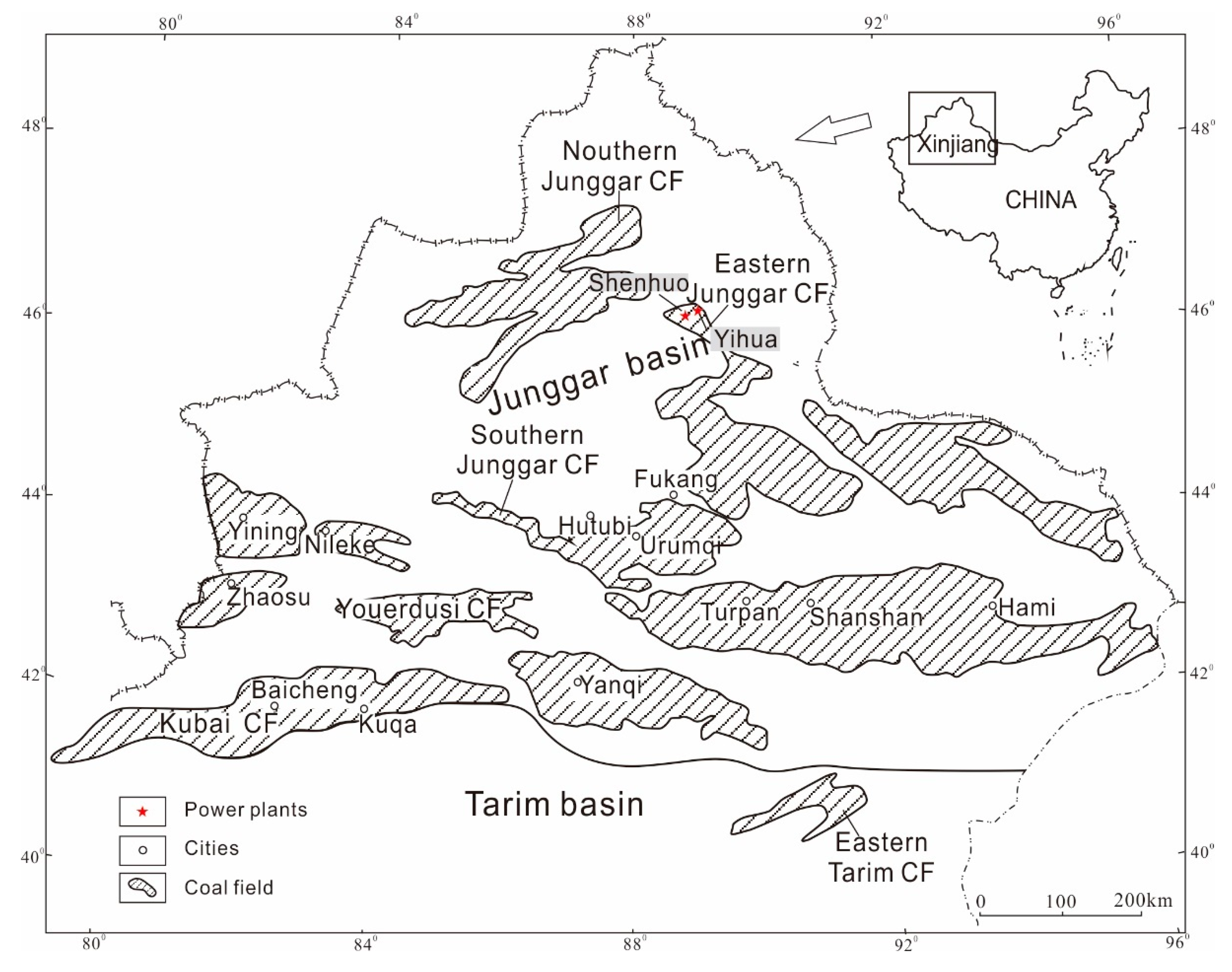
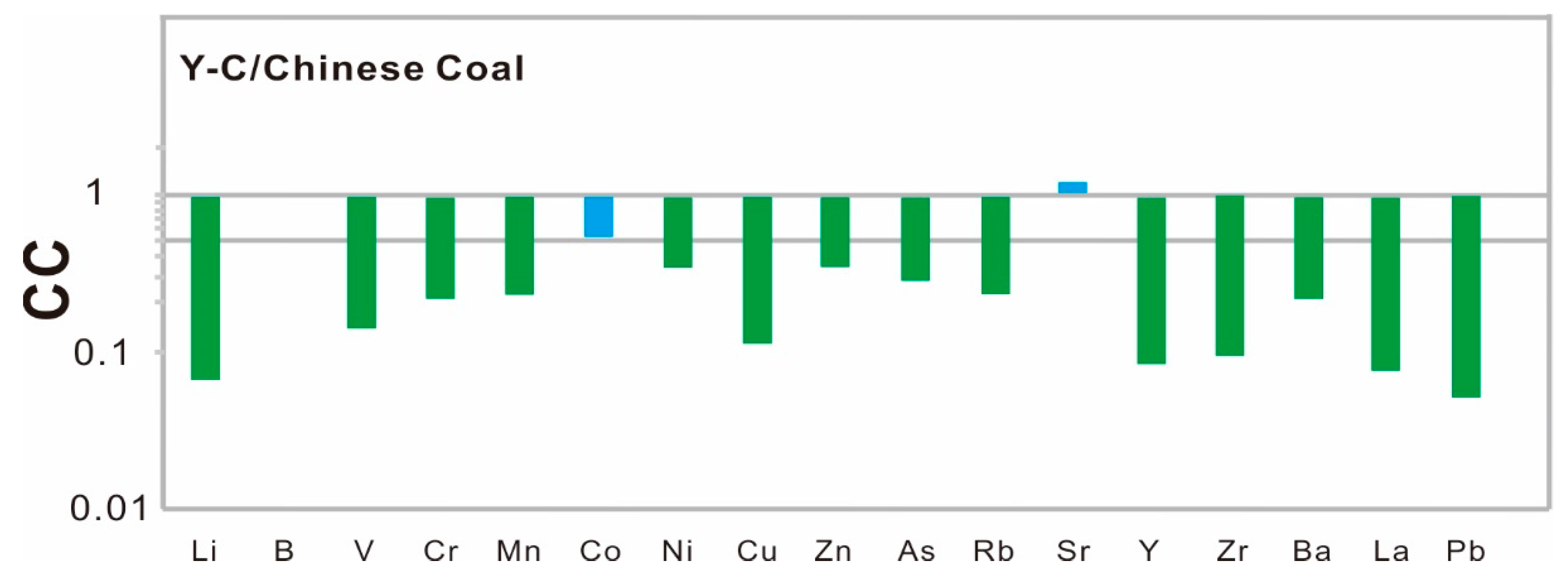
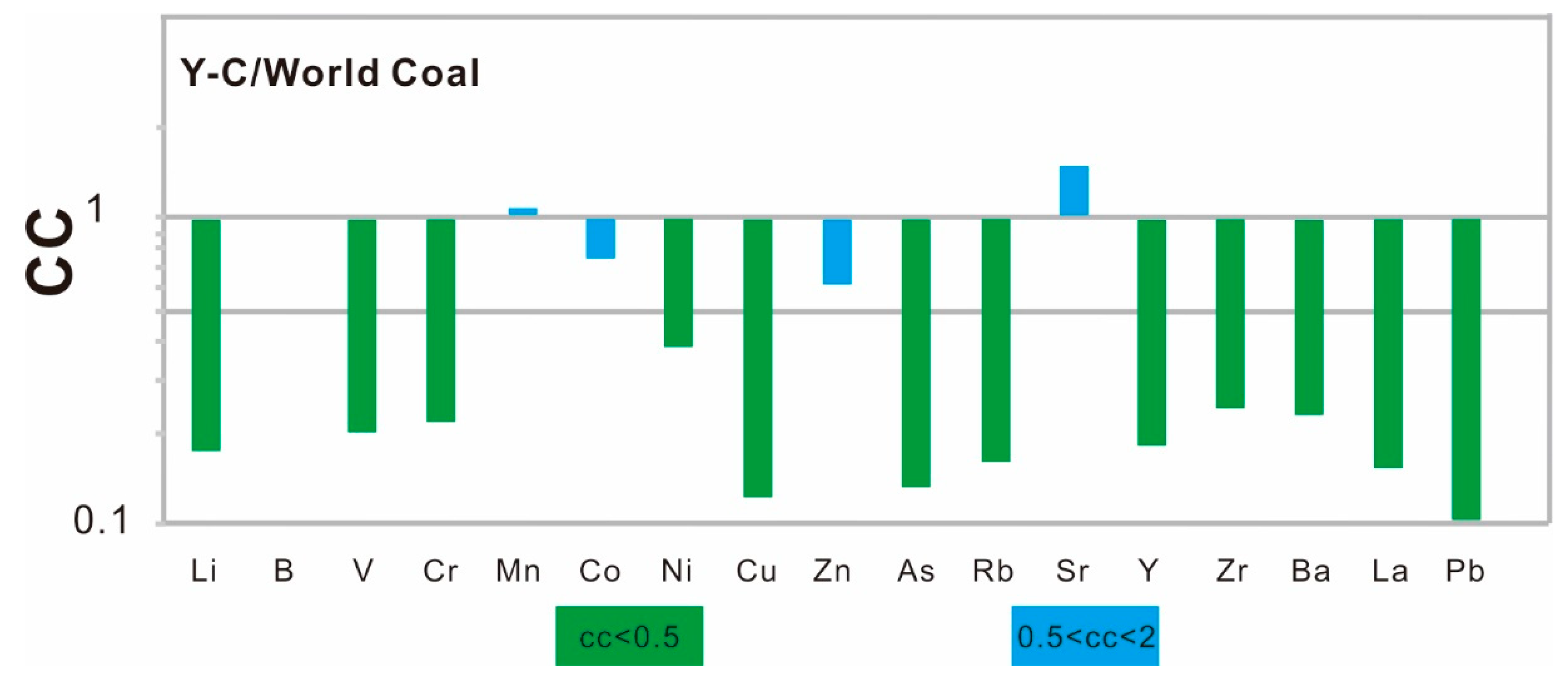
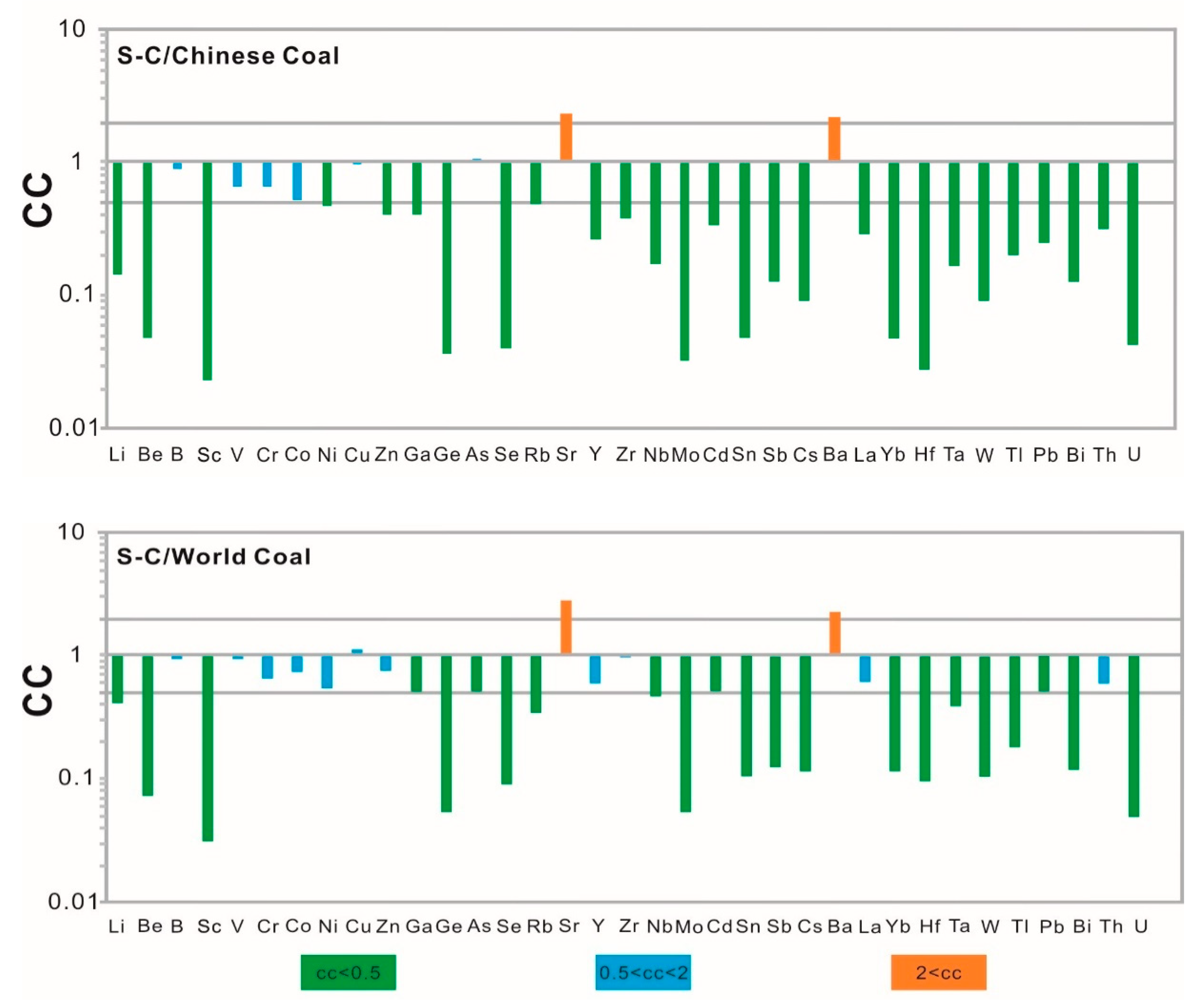

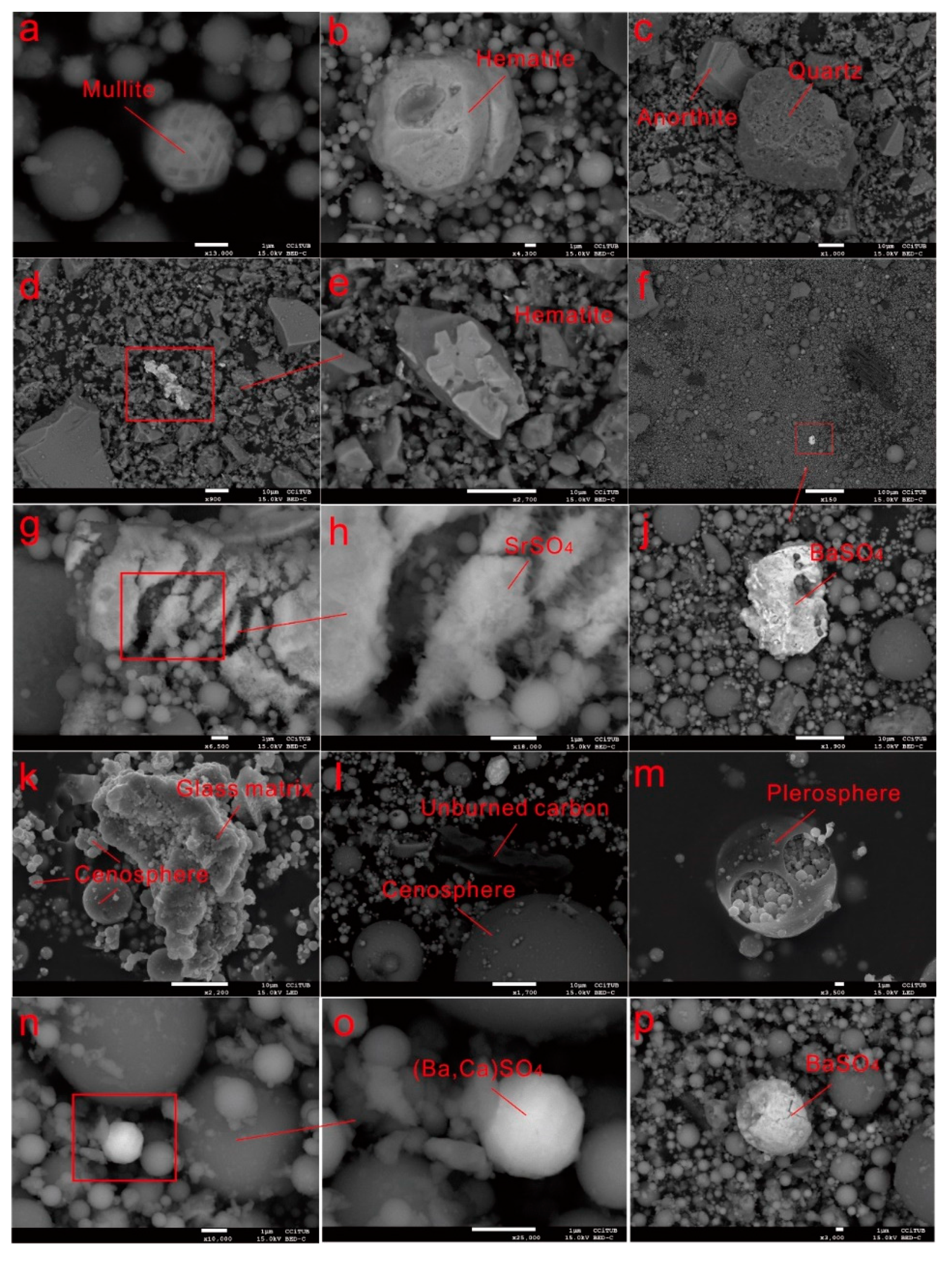
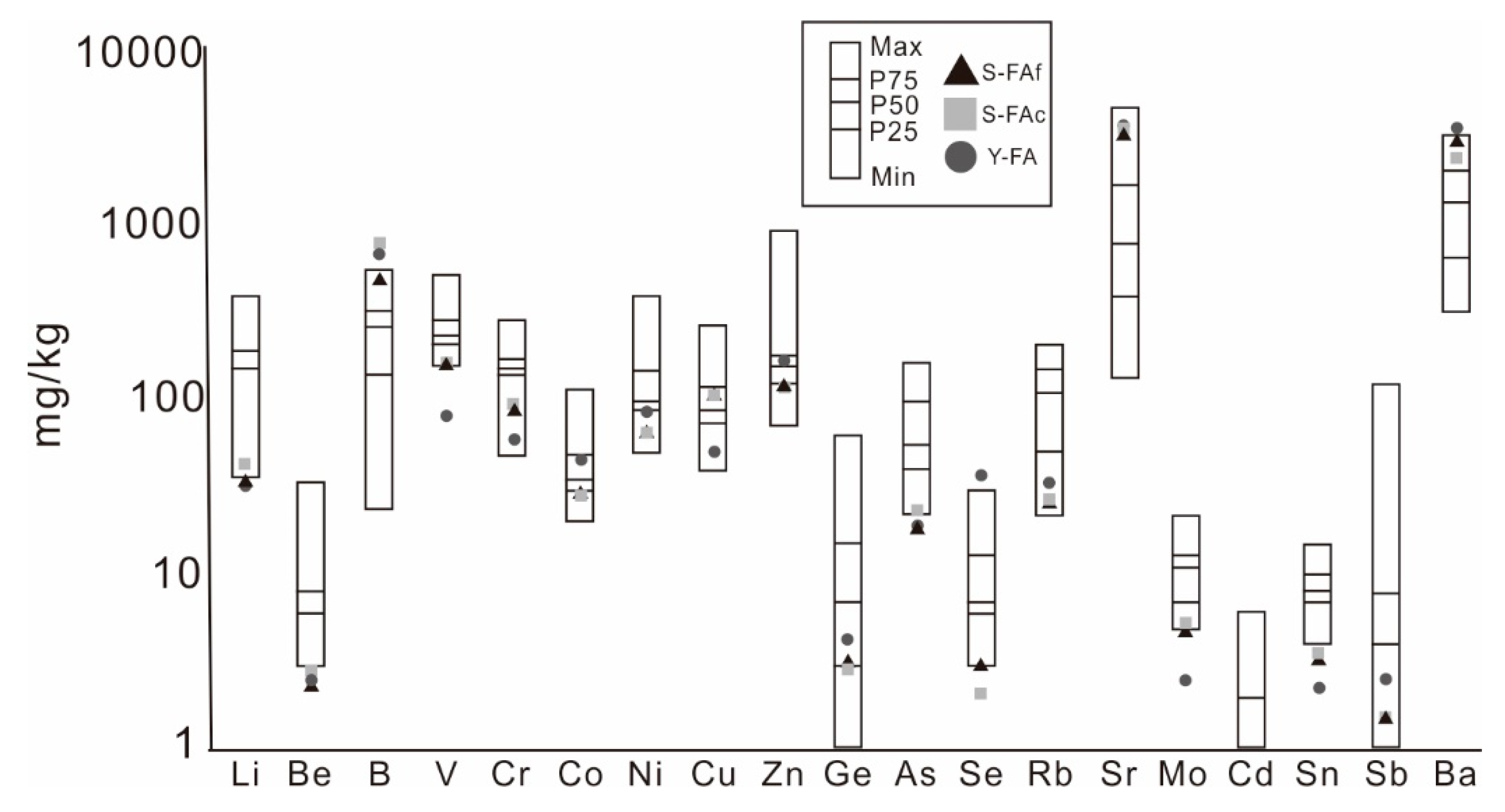


| Feed Coal | M (ad, %) | HTA (d, %) | VM (daf, %) | C (daf, %) | S (db, %) | CV(ar, mJ/kg) |
|---|---|---|---|---|---|---|
| Y-C | 12.32 | 4.81 | 31.97 | 68.03 | 0.52 | 22.22 |
| S-C | 11.33 | 13.86 | 34.68 | 65.32 | 0.50 | 23.36 |
| Y-C | S-C | Chinese a | World b | Y-C | S-C | Chinese a | World b | ||
|---|---|---|---|---|---|---|---|---|---|
| % | mg/kg | ||||||||
| Al2O3 | 0.9 | 2.9 | 6 | nd | As | 1.1 | 4 | 3.8 | 8.3 |
| CaO | 1.3 | 1.6 | 1.2 | nd | Se | <dl | <dl | 2.5 | 1.3 |
| Fe2O3 | 0.2 | 0.9 | 4.9 | nd | Rb | 2.2 | 4.4 | 9.3 | 14 |
| K2O | 0.1 | 0.1 | 0.2 | nd | Sr | 165 | 314 | 140 | 110 |
| MgO | 0.3 | 0.3 | 0.2 | nd | Y | 1.5 | 4.6 | 18 | 8.4 |
| Na2O | 0.3 | 0.2 | 0.2 | nd | Zr | 8.7 | 33.4 | 90 | 36 |
| SO3 | 0.5 | 1.3 | 0.25 | nd | Nb | <dl | 1.6 | 9.4 | 3.7 |
| mg/kg | Mo | <dl | <dl | 3.1 | 2.2 | ||||
| Li | 2.1 | 4.5 | 32 | 12 | Cd | <dl | <dl | 0.3 | 0.2 |
| Be | <dl | <dl | 2.1 | 1.6 | Sn | <dl | <dl | 2.1 | 1.1 |
| B | 52.5 | 47.1 | 53 | 52 | Sb | <dl | <dl | 0.8 | 0.9 |
| P | 38.5 | 314.3 | 402 | nd | Cs | <dl | <dl | 1.1 | 1 |
| Sc | <dl | <dl | 4.4 | 3.9 | Ba | 34.3 | 335 | 159 | 150 |
| Ti | 246 | 723 | 1980 | nd | La | 1.7 | 6.4 | 22.5 | 11 |
| V | 5.0 | 22.5 | 35 | 25 | Ce | 3.1 | 11.7 | 46.7 | 23 |
| Cr | 3.5 | 9.9 | 15 | 16 | Sm | <dl | 1.2 | 4.1 | 2 |
| Mn | 27.1 | 124 | 116 | nd | Dy | <dl | 0.8 | 3.7 | 2.1 |
| Co | 3.8 | 3.6 | 7.1 | 5.1 | Hf | <dl | <dl | 3.7 | 1.2 |
| Ni | 5.0 | 6.6 | 14 | 13 | W | <dl | <dl | 1.1 | 1.1 |
| Cu | 2.0 | 17.3 | 18 | 16 | Pb | 0.8 | 3.8 | 15.1 | 7.8 |
| Zn | 14.2 | 16.5 | 41 | 23 | Th | <dl | 1.8 | 5.8 | 3.3 |
| Ga | <dl | 2.6 | 6.6 | 5.8 | U | <dl | <dl | 2.4 | 2.4 |
| Ge | <dl | <dl | 2.8 | 2.2 |
| % | Y-FA | Y-Slag | S-FAf | S-FAc | S-Slag | EU Fly Ashes * |
|---|---|---|---|---|---|---|
| Moisture | 0.9 | 0.02 | 0.5 | 0.5 | 0.1 | 0–2.4 |
| LOI | 5.4 | 0.1 | 3.6 | 3.4 | 0.6 | 1.1–8.1 |
| Crystalline species | ||||||
| Amorphous phase | 86.5 | 75 | 83.0 | 77.6 | 56.0 | 48–89 |
| Quartz | 0.4 | 8 | 4.8 | 6.4 | 7.2 | 1.7–13 |
| Mullite | <dl | <dl | 6.5 | 7.5 | 9.9 | 3.2–40 |
| Calcite | 8.5 | <dl | 2.2 | 3.3 | 3.3 | <0.3–0.6 |
| Lime | 0.2 | <dl | 0.6 | 0.8 | <dl | <0.3–5.8 |
| Periclase | 1.1 | <dl | 1.0 | 1.7 | <dl | nd |
| Anhydrite | 2.6 | <dl | 1.9 | 2.5 | <dl | 0.2–15 |
| Magnetite | 0.1 | <dl | <dl | 0.2 | <dl | 0.1–5.0 |
| Anorthite | <dl | 4.6 | <dl | <dl | 23.6 | nd |
| Hematite | 0.6 | <dl | <dl | <dl | <dl | 2.5–5.9 |
| Augite | <dl | 12.4 | <dl | <dl | <dl | nd |
| Glass composition | ||||||
| SiO2 | 52.5 | 54.1 | 45.3 | 45.6 | 49.8 | 31.4–65.5 |
| Al2O3 | 12.9 | 11.0 | 18.5 | 18.7 | 19.6 | 5.4–29.1 |
| CaO | 22.6 | 10.9 | 13.2 | 14.8 | 8.6 | 0.6–24.4 |
| Fe2O3 | 6.1 | 9.3 | 8.6 | 6.9 | 10.5 | 4.1–15.9 |
| SO3 | 3.9 | 0.3 | 1.9 | 1.8 | 0.7 | <0.1–1.6 |
| SiO2/Al2O3 | 4.1 | 4.9 | 2.4 | 2.4 | 2.5 | 1.1–9.4 |
| % | Y-FA | Y-Slag | S-FAf | S-FAc | S-Slag | EU Fly Ashes * |
|---|---|---|---|---|---|---|
| Al | 6.8 | 5.8 | 9.8 | 9.9 | 10.4 | 9.3–18.8 |
| Ca | 16.1 | 7.8 | 9.4 | 10.6 | 6.1 | 0.4–19.5 |
| Fe | 4.3 | 6.5 | 6.1 | 4.8 | 7.3 | 1.8–11.2 |
| K | 0.9 | 1.1 | 0.5 | 0.5 | 0.5 | 0.3–3.3 |
| Mg | 2.2 | 0.9 | 1.7 | 2.1 | 0.9 | 0.4–2.3 |
| Na | 2.9 | 2.5 | 1.5 | 1.9 | 1 | 0.1–0.9 |
| S | 1.6 | 0.1 | 0.7 | 0.7 | 0.3 | 0.0–3.4 |
| P | 0.1 | 0.1 | 0.2 | 0.2 | 0.2 | nd |
| Ti | 0.4 | 0.3 | 0.6 | 0.5 | 0.6 | nd |
| Mn | 0.1 | <dl | 0.1 | 0.1 | 0.1 | nd |
| mg/kg | ||||||
| Li | 29.8 | 22.8 | 33 | 40.8 | 32.1 | 36–377 |
| Be | 2.4 | 1.8 | 2.2 | 2.7 | 2.2 | 3–34 |
| B | 635.3 | 39.0 | 452 | 710 | 100 | 24–534 |
| Sc | 7.5 | 6.1 | 16.5 | 15.6 | 15.6 | nd |
| V | 77.4 | 59.9 | 155 | 154 | 122 | 14–514 |
| Cr | 58.4 | 35.8 | 81.8 | 89.8 | 74.8 | 47–281 |
| Co | 42.0 | 30.1 | 27.7 | 26 | 22.8 | 20–112 |
| Ni | 81.6 | 53.9 | 60.1 | 60.2 | 54 | 49–377 |
| Cu | 46.7 | 29.4 | 99.4 | 99.4 | <dl | 39–254 |
| Zn | 163.4 | 53.2 | 113 | 109 | 66.8 | 70–924 |
| Ga | 13.8 | 5.9 | 21.6 | 24.5 | 10.1 | nd |
| Ge | 4.2 | 1.1 | 3.1 | 2.8 | <dl | 1–61 |
| As | 18.1 | 10.0 | 17.6 | 21.7 | 7.4 | 22–162 |
| Se | 36.7 | <dl | 2.9 | 2 | <dl | 3–30 |
| Rb | 31.6 | 35.5 | 24.4 | 25.5 | 25.4 | 22–202 |
| Sr | 3351.8 | 2289.5 | 2889 | 3299 | 2127 | 131–4406 |
| Y | 23.4 | 24.2 | 33.6 | 34.3 | 33.3 | nd |
| Zr | 93.0 | 158.5 | 182 | 180 | 182 | nd |
| Nb | 3.6 | 6.1 | 9.2 | 6.2 | 10.6 | nd |
| Mo | 2.3 | 1.2 | 4.5 | 5 | 1.9 | 5–22 |
| Cd | <dl | <dl | <dl | <dl | <dl | 1–6 |
| Sn | 2.2 | 0.9 | 3.2 | 3.3 | 1 | 4–15 |
| Sb | 2.5 | <dl | 1.5 | 1.4 | <dl | 1–120 |
| Cs | 2.2 | 1.4 | 3.6 | 3.8 | 3.8 | nd |
| Ba | 3435.2 | 2302.7 | 2743 | 2182 | 2568 | 311–3134 |
| La | 25.1 | 28.7 | 44.8 | 46.4 | 45.6 | nd |
| Ce | 47.7 | 56.2 | 82.3 | 86.8 | 84.6 | nd |
| Pr | 5.3 | 6.5 | 9.6 | 10 | 9.7 | nd |
| Nd | 20.8 | 26.0 | 37.1 | 39.4 | 37.8 | nd |
| Sm | 4.8 | 6.0 | 8.2 | 8.7 | 8.1 | nd |
| Eu | 1.3 | 1.5 | 1.9 | 1.9 | 2 | nd |
| Gd | 4.4 | 5.3 | 7.4 | 7.6 | 7.4 | nd |
| Tb | <dl | <dl | 1 | 1 | 1 | nd |
| Dy | 4.1 | 4.6 | 6.2 | 6.3 | 6.1 | nd |
| Ho | 0.8 | 0.9 | 1.2 | 1.2 | 1.2 | nd |
| Er | 2.3 | 2.4 | 3.3 | 3.4 | 3.3 | nd |
| Tm | <dl | <dl | 0.9 | 0.9 | 0.9 | nd |
| Yb | 2.5 | 2.5 | 3.4 | 3.4 | 3.3 | nd |
| Lu | <dl | <dl | <dl | <dl | <dl | nd |
| Hf | 3.0 | 4.1 | 4.9 | 5 | 5 | nd |
| Ta | <dl | <dl | <dl | <dl | <dl | nd |
| W | 4.7 | 1.0 | 3.4 | 5 | 1.7 | nd |
| Tl | 0.9 | <dl | <dl | 0.8 | <dl | nd |
| Pb | 21.8 | 3.9 | 26.5 | 31.4 | 4.7 | 40–1075 |
| Bi | <dl | <dl | <dl | <dl | <dl | nd |
| Th | 5.7 | 5.6 | 11.4 | 11.3 | 11.1 | 17–65 |
| U | 2.3 | 1.8 | 4 | 4.4 | 3.2 | 5–29 |
| EFAY | EFSY | EFTY | EFAS | EFSS | EFTS | EFAY | EFSY | EFTY | EFAS | EFSS | EFTS | ||
|---|---|---|---|---|---|---|---|---|---|---|---|---|---|
| Al | 1.0 | 1.0 | 1.0 | 1.0 | 1.0 | 1.0 | Ga | nd | nd | nd | 1.4 | 0.6 | 1.3 |
| Ca | 1.2 | 0.7 | 1.1 | 1.3 | 0.8 | 1.3 | As | 1.1 | 0.7 | 1.1 | 0.8 | 0.3 | 0.7 |
| Fe | 2.2 | 4.0 | 2.4 | 1.2 | 1.6 | 1.3 | Rb | 1.0 | 1.3 | 1.0 | 0.9 | 0.8 | 0.9 |
| K | 0.9 | 1.3 | 0.9 | 0.8 | 0.8 | 0.8 | Sr | 1.4 | 1.1 | 1.4 | 1.5 | 1 | 1.5 |
| Mg | 0.9 | 0.4 | 0.9 | 1.5 | 0.6 | 1.4 | Y | 1.1 | 1.3 | 1.1 | 1.1 | 1.1 | 1.1 |
| Na | 0.8 | 0.8 | 0.8 | 1.6 | 0.9 | 1.5 | Zr | 1.1 | 1.3 | 0.8 | 0.8 | 0.8 | 0.8 |
| S | 0.5 | 0.0 | 0.5 | 0.2 | 0.1 | 0.2 | Nb | nd | nd | nd | 0.7 | 1 | 0.7 |
| P | 1.3 | 1.0 | 1.3 | 1.1 | 0.7 | 1.0 | Ba | 6.9 | 5.4 | 6.7 | 1.1 | 1.1 | 1.1 |
| Ti | 1.0 | 0.9 | 1.0 | 1.2 | 1.1 | 1.2 | La | 1.0 | 1.1 | 1.0 | 1.1 | 1.0 | 1.1 |
| Mn | 1.4 | 1.3 | 1.4 | 1.4 | 1.4 | 1.4 | Ce | 1.0 | 1.4 | 1.1 | 1.1 | 1.1 | 1.1 |
| Li | 1.0 | 0.9 | 1.0 | 1.3 | 1 | 1.3 | Pr | nd | nd | nd | 1.1 | 1 | 1.1 |
| B | 0.8 | 0.1 | 0.8 | 2.0 | 0.3 | 1.8 | Nd | 1.0 | 1.5 | 1.1 | 1.1 | 1.1 | 1.1 |
| V | 1.1 | 1.0 | 1.1 | 1.1 | 0.8 | 1 | Sm | nd | nd | nd | 1.1 | 1 | 1.1 |
| Cr | 1.2 | 0.8 | 1.1 | 1.3 | 1.1 | 1.3 | Gd | nd | nd | nd | 1.2 | 1.1 | 1.1 |
| Co | 0.8 | 0.6 | 0.7 | 1.2 | 0.9 | 1.1 | Dy | 1.2 | 1.2 | 1.2 | 1.1 | 1.2 | |
| Ni | 1.1 | 0.9 | 1.1 | 1.4 | 1.2 | 1.4 | Pb | 1.9 | 0.4 | 1.7 | 1.2 | 0.2 | 1.1 |
| Cu | 1.6 | 1.2 | 1.6 | 0.9 | 0 | 0.8 | Th | nd | nd | nd | 1 | 0.9 | 1 |
| Zn | 0.8 | 0.3 | 0.7 | 1 | 0.6 | 1 |
| Limitvalues2003/33/CE [43] | ||||||||
|---|---|---|---|---|---|---|---|---|
| ppm | Y-FA | Y-Slag | S-FAf | S-FAc | S-Slag | Inert | Non-Hazardous | Hazardous |
| Al | 5.8 | 3.9 | <dl | <dl | 0.2 | |||
| Ca | 32.4 | 382.0 | 4688 | 3702 | 1611 | |||
| Fe | <dl | <dl | <dl | <dl | <dl | |||
| K | 331.6 | 7.6 | 7.4 | 5.1 | 16.2 | |||
| Mg | 0.6 | 3.3 | 0.1 | 0.1 | 113 | |||
| Mn | <dl | <dl | <dl | <dl | <dl | |||
| Na | 3428.8 | 142.2 | 333 | 191 | 146 | |||
| P | <dl | <dl | <dl | <dl | <dl | |||
| S | 1020.0 | 201.8 | 578 | 21.2 | 1508 | |||
| Si | 114.5 | 112.6 | 0.8 | 0.6 | 31.1 | |||
| ppb | ||||||||
| Li | 75.1 | <dl | 250 | 228 | 257 | |||
| Be | <dl | <dl | <dl | <dl | <dl | |||
| B | 8186.6 | 16.0 | 2354 | 694 | 17,448 | |||
| Sc | <dl | <dl | <dl | <dl | <dl | |||
| Ti | <dl | <dl | <dl | <dl | <dl | |||
| V | 215.9 | <dl | 23.8 | 30.8 | 88.4 | |||
| Cr | 59.8 | <dl | 1605 | 206 | <dl | 500 | 10,000 | 70,000 |
| Mn | <dl | <dl | <dl | <dl | 34.3 | |||
| Co | <dl | <dl | <dl | <dl | <dl | |||
| Ni | <dl | <dl | 24.6 | 11.4 | 12.2 | 400 | 10,000 | 40,000 |
| Cu | 4.1 | 0.1 | <dl | 8.3 | 44.8 | 2000 | 50,000 | 100,000 |
| Zn | <dl | 18.8 | <dl | <dl | 57.7 | 4000 | 50,000 | 200,000 |
| Ga | <dl | <dl | <dl | 234 | 4.0 | |||
| Ge | <dl | <dl | <dl | <dl | <dl | |||
| As | 68.1 | <dl | <dl | 5.7 | 22.0 | 500 | 2000 | 25,000 |
| Se | 0.0 | <dl | 164 | 5.8 | <dl | 100 | 500 | 7000 |
| Rb | 11.6 | <dl | 23.4 | 24.9 | 27.5 | |||
| Sr | 8382.5 | 2.0 | 292,448 | 487,672 | 81,989 | |||
| Y | <dl | <dl | <dl | <dl | <dl | |||
| Zr | <dl | <dl | <dl | <dl | <dl | |||
| Nb | <dl | <dl | <dl | <dl | <dl | |||
| Mo | 10.6 | <dl | 897 | 223 | 27.4 | 500 | 10,000 | 30,000 |
| Cd | <dl | <dl | <dl | <dl | <dl | 40 | 1000 | 5000 |
| Sn | <dl | <dl | <dl | <dl | <dl | |||
| Sb | <dl | <dl | <dl | <dl | 19.1 | 60 | 700 | 5000 |
| Cs | <dl | <dl | <dl | <dl | <dl | |||
| Ba | 485.8 | <dl | 3552 | 104,720 | 749 | 2000 | 100,000 | 300,000 |
| Hf | <dl | <dl | <dl | <dl | <dl | |||
| W | 24.2 | <dl | <dl | <dl | <dl | |||
| Tl | <dl | <dl | <dl | <dl | <dl | |||
| Pb | <dl | <dl | <dl | <dl | <dl | 500 | 10,000 | 50,000 |
| Th | <dl | <dl | <dl | <dl | <dl | |||
| U | <dl | <dl | <dl | <dl | <dl | |||
© 2019 by the authors. Licensee MDPI, Basel, Switzerland. This article is an open access article distributed under the terms and conditions of the Creative Commons Attribution (CC BY) license (http://creativecommons.org/licenses/by/4.0/).
Share and Cite
Wu, P.; Li, J.; Zhuang, X.; Querol, X.; Moreno, N.; Li, B.; Ge, D.; Zhao, S.; Ma, X.; Cordoba, P.; et al. Mineralogical and Environmental Geochemistry of Coal Combustion Products from Shenhuo and Yihua Power Plants in Xinjiang Autonomous Region, Northwest China. Minerals 2019, 9, 496. https://doi.org/10.3390/min9080496
Wu P, Li J, Zhuang X, Querol X, Moreno N, Li B, Ge D, Zhao S, Ma X, Cordoba P, et al. Mineralogical and Environmental Geochemistry of Coal Combustion Products from Shenhuo and Yihua Power Plants in Xinjiang Autonomous Region, Northwest China. Minerals. 2019; 9(8):496. https://doi.org/10.3390/min9080496
Chicago/Turabian StyleWu, Peng, Jing Li, Xinguo Zhuang, Xavier Querol, Natalia Moreno, Baoqing Li, Dongfeng Ge, Shihua Zhao, Xiaoping Ma, Patricia Cordoba, and et al. 2019. "Mineralogical and Environmental Geochemistry of Coal Combustion Products from Shenhuo and Yihua Power Plants in Xinjiang Autonomous Region, Northwest China" Minerals 9, no. 8: 496. https://doi.org/10.3390/min9080496
APA StyleWu, P., Li, J., Zhuang, X., Querol, X., Moreno, N., Li, B., Ge, D., Zhao, S., Ma, X., Cordoba, P., & Shangguan, Y. (2019). Mineralogical and Environmental Geochemistry of Coal Combustion Products from Shenhuo and Yihua Power Plants in Xinjiang Autonomous Region, Northwest China. Minerals, 9(8), 496. https://doi.org/10.3390/min9080496






